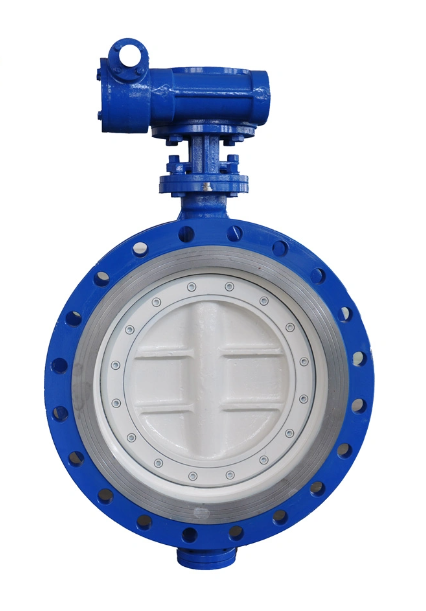Triple offset butterfly valves are compatible with various actuation methods that enable precise control and automation in fluid systems. The choice of actuation method depends on the specific application's requirements and the desired level of control.
Here are some common actuation methods for triple offset butterfly valves:Manual Actuation: Manual actuation involves the use of a handwheel, lever, or gear operator to open or close the valve. While it is simple and cost-effective, manual actuation is typically used for smaller valves or applications where remote or automated control is not necessary.
Electric Actuation: Electric actuators use an electric motor to control the valve's position. They are suitable for applications where precise control and automation are needed. Electric actuators can be integrated into control systems and operated remotely.
Pneumatic Actuation: Pneumatic actuators use compressed air to control the valve's position. They are commonly used in industrial settings where quick response times are necessary. Pneumatic actuators are often chosen for fail-safe applications.
Hydraulic Actuation: Hydraulic actuators use pressurized hydraulic fluid to control the valve's movement. They are suitable for applications where high force and precision control are required, such as in large-diameter valves.
Spring-Return Actuation: Spring-return actuators are typically used in fail-safe applications. They use a spring mechanism to return the valve to a specific position when power or air pressure is lost.
Double-Acting Actuation: Double-acting actuators use both opening and closing fluid pressures to control the valve's position. They provide precise control and can be used for modulating applications.
Digital or Smart Actuation: Some triple offset butterfly valves can be equipped with digital or smart actuators that are integrated into control systems. These actuators may provide features like position feedback, diagnostics, and remote control.
Multi-Turn and Quarter-Turn Actuation: The type of actuation chosen can be either multi-turn or quarter-turn, depending on the valve's design and application. Multi-turn actuators are used for linear movement, while quarter-turn actuators are suitable for valves with 90-degree rotational movement, such as butterfly valves.
Modulating Actuation: For applications that require precise flow control, modulating actuators can be used to adjust the valve's position continuously. These actuators are suitable for maintaining specific flow rates or pressure levels.
The choice of actuation method depends on factors such as the desired level of control, system requirements, environmental conditions, and the need for automation. Triple offset butterfly valves are versatile and can be adapted to various actuation methods to meet the specific demands of different applications.
What industry standards or regulations govern the use of triple offset butterfly valves in specific applications?The use of triple offset butterfly valves is subject to industry standards and regulations that vary depending on the specific application and the location in which the valves are used. These standards and regulations are in place to ensure the safe and reliable operation of valves in various industries. Some relevant standards and regulations include:
American Petroleum Institute (API): API standards, such as API 609, provide specifications for triple offset butterfly valves. This standard covers design, materials, testing, and performance requirements for industrial valves.
American Water Works Association (AWWA): AWWA standards, such as AWWA C504 and AWWA C504M, are applicable to triple offset butterfly valves used in water distribution and wastewater treatment systems.
American Society of Mechanical Engineers (ASME): ASME standards,
triple offset butterfly valve including ASME B16.34 and ASME B16.5, offer guidelines for valve design, materials, and dimensions in various industrial applications.
International Organization for Standardization (ISO): ISO standards, such as ISO 10434, provide general specifications for triple offset butterfly valves used in a wide range of industries worldwide.
European Norm (EN): EN standards, such as EN 593, are relevant for triple offset butterfly valves used in Europe and other regions that adopt European standards.
Fire-Safe Testing Standards: Triple offset butterfly valves may need to comply with fire-safe testing standards such as API 607, API 6FA, or ISO 10497, especially when used in applications where fire safety is critical.
European Pressure Equipment Directive (PED): The PED is applicable in Europe and addresses the safety of pressure equipment, including valves.
NACE International: For applications in the oil and gas industry, NACE MR0175/ISO 15156 provides guidelines for materials selection to prevent corrosion in sour service environments.
Application-Specific Standards: Various industries, such as the chemical, petrochemical, food and beverage, pharmaceutical, and power generation industries, may have specific standards or guidelines for valve selection and use.
It's important to note that the specific standards and regulations that apply to triple offset butterfly valves will depend on factors such as the industry, location, fluid being controlled, and safety requirements. Compliance with these standards ensures that valves are designed, manufactured, tested, and used in a manner that meets safety, performance, and environmental considerations. Consulting with regulatory bodies and valve manufacturers is recommended to ensure compliance with relevant standards for specific applications.

